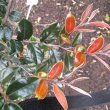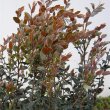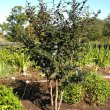| Botanical Name |
|
| Family |
Ebenaceae - The ebony family. |
| Pronunciation |
dy-oh-SPY-ros why-tee-AH-nuh |
| Common Name(s) |
English: Bladder-nut; Blackbark
Afrikaans: Swartbas; Bostolbos; Kraaibessie
IsiZulu: uManzimane; umKahze
Sesotho sa Leboa: Mohlatsane
Tshivenda: Munyavhili; Mwanda
|
| Plant Group |
- Tree A woody, self-supporting perennial plant usually with a single main stem and generally growing more than 6 meters tall.
|
| Plant Size |
- Small
| Tree | 4m to 8m |
| Shrub | 50cm to 75cm |
| Perennial/ground cover | 10cm to 20cm |
| Bulb | 20cm to 30cm |
| Succulent | 10cm to 20cm |
|
| Position |
- Partial Shade The area is in shade for part of the day and in full sun for part of the day.
- Sun The area is in full sun for all or most of the day, all year round.
|
| General Information |
- Attractive fruits, berries or seeds Brightly coloured fruits or berries increase and extend the visual impact of the plant and are especially attractive to birds and other small wildlife.
- Drought Tolerance: High The plant is well adapted to arid conditions; it can survive long periods of drought and high temperatures without extra water.
- Evergreen Plants that have leaves all year round.
- Fragrant / Aromatic These plants posses a strong, usually pleasant odour.
- Frost: Hardy The plant can withstand freezing temperatures or frost without artificial protection.
- Roots Non-invasive Safe to plant near pools, paving, walls or buildings.
- Water Wise Plant species originating from low rainfall regions that require less water to survive and thrive than other plant species.
|
| Specific Information |
Diospyros whyteana is an attractive tree for the garden with dark green, glossy leaves, fragrant flowers and intriguing balloon-like fruits. It grows as a shrub or small tree which branches low down and forms a dense canopy with a pleasing shape. The new foliage is copper coloured and adds an extra dimension to this appealing plant. The fleshy berries turn red when ripe in summer and are enclosed in bladder-like capsules which dry to reddish-bown and remain on the tree well after the seeds have fallen.
|
| Ad Break |
|
| Flowers |
| Description |
small with rounded petals that fold back as they age - a bit like a pixie hat
|
| Season |
- Spring Plants will seldom bloom for the entire season as given in the list, but should flower during a period within these parameters.
|
| Colour |
|
| Growth Rate |
- Moderate Specifying growth rate can be very misleading as there is considerable variation of growth rate depending on type and species of plant, available water, supplementary feeding, mulching and general care, as well as the plants suitability and adaptability to the garden environment.
|
| Plant Uses |
- Attracts bees, butterflies or other insects This plant attracts insects which can be food for birds or other creatures in your garden.
- Attracts Birds This plant will attract birds.
- Container Trees, shrubs and ornamental species that can adapt to growing in a restricted environment.
- Hedge Suitable trees or shrubs planted relatively close together so that the branches intertwine to create a barrier. This can be formal – the plants are regularly trimmed to produce a neat shape, or informal – the plants are left to themselves to create a natural hedgerow.
- Provides light / dappled shade A tree with an open to sparse canopy, through which varying degrees of sunlight can penetrate.
- Screen A tall hedge of suitable plants planted closely together and used as a windbreak, to block a bad view, to separate parts of the garden or as a backdrop.
- Suitable for bonsai A shrub or tree that lends itself to being dwarfed.
- Suitable for coastal gardens Plants adapted to dry, sandy soil, forceful wind, limited rainfall and intense sunlight.
- Suitable for smaller gardens Such plants do not have invasive root systems, remain small or controllable and can often be grown in containers.
- Wild Garden An indigenous garden planted for the benefit of wildlife and birds. Provides food, water, a variety of mini-biomes and no poisonous chemicals are used.
|
| Distribution and Habitat |
from the Western Cape to the Eastern Cape, KwaZulu-Natal, Mpumalanga, Free State, Gauteng, Limpopo and North West, and north as far as Ethiopia, in scrub, forest, on mountain slopes and in rocky places
|
| Planting Suggestions |
Mulch well but make sure the area around the trunk is clear. Further applications of compost, manure or fertiliser during the year will result in a strong, healthy root system and faster growth. Diospyros whyteana responds well to pruning to keep it in shape and can be clipped to form a dense hedge.
The old method of digging a deep hole and filling it with soil and compost has resulted in many trees failing to thrive, dying, rotting at the base or worse still, falling over in later years due to poor root development. Refer to the following sites for the best method of planting trees:
Treehelp.com: Planting a tree
International Society of Arboriculture: New Tree Planting
Tree People: Plant the right way
For those of you who have a clay problem try:
Rod's Garden: Planting in clay soil
|
| Medicinal Uses |
A combination of roots and leaves is soaked in water to treat rashes and an extract of the bark is given as an enema for treating menstrual pain, impotence and infertility.
|
| Ad Break |
|









Discuss this plant
Share knowledge, ask a question or give an experience.